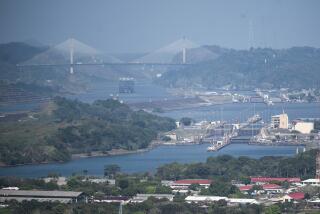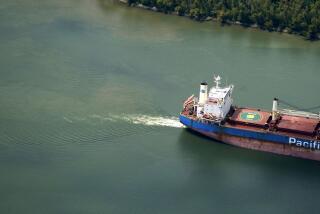Drought Threatening River Traffic : Falling Water Levels on Mississippi, Ohio Affect Vital Shipping
- Share via
GREENVILLE, Miss. — Drought is causing America’s great river highway, the mighty Mississippi, to run low on water.
One of the driest spring seasons in a half-century is also dropping water levels dangerously low on other rivers, great and small, that depend on watersheds in the Midwest, Southeast and Northwest to keep them flowing.
But the most serious impact this spring may be here on the Mississippi and on the Ohio--waterways where the movement of cargoes of grain, fuel oil, coal, salt and fertilizer are vital to the commerce and economy of Mid-America.
Low water does to river traffic what narrowing a freeway from six lanes to one would do to car and truck traffic--it reduces shallow channels to one-way lanes. At thesame time, it cuts the cargo that can be loaded on each barge and limits the number of barges towboats can navigate through thenarrow channels from groups of 40 or more to groups of only about 25.
And, in the last week alone, low water has left the Mississippi impassable here at Greenville and on the Ohio near Mound City, Ill.
By Saturday, an estimated 2,000 barges and more than 70 towboats were stranded at these two bottlenecks. During the day, the riverbanks for 30 miles north and south of Greenville were lined with coal- and grain-laden barges and idling towboats stalled in the drought-starved river. The bottleneck was finally broken and river traffic resumed for the first time in a week late Saturday after days of round-the-clock dredging cleared the way.
On the Ohio, a 7-mile-long stretch of river east of where it joins with the Mississippi was also closed to river traffic most of the week, but opened by day’s end Saturday.
The low water on the Mississippi exposed broad sandy beaches--not a common sight this time of year--and banks littered with the cast-off junk and trash of 20th-Century America: soft-drink cans, plastic bags and cups, rusted cars, driftwood and broken bottles.
At Memphis, Tenn., one of the 20 places on the Lower Mississippi where engineers expect trouble this spring and summer, the river was 19 feet below normal for this time of year and dropping. Here at Greenville the river was expected to fall 6 inches between last Friday and tonight.
“The river is not drying up. That’s not going to happen,” said Jack Hill, the Corps of Engineers’ chief of construction and operations on the Lower Mississippi. “We’re just going to see a very cautious and uncertain navigation season.”
Dredging of the kind that was needed here last week is usually seen on the river only in the autumn, after the dry hot months of a normal summer. The need to dredge so early this year is worrisome to both boat captains and to the Corps of Engineers.
“We’re looking at a situation that’s going to be summer-long,” said Michael Logue, a spokesman for the U.S. Army Corps of Engineers in Vicksburg, Miss. “Greenville is the first skirmish in a summer-long siege (of low water).”
The unthinkable--closing the river to traffic altogether--is nervously being discussed, but neither Corps of Engineers officials nor boat captains were willing to be quoted on the possibility. “Sure we’re thinking about it. It’s a strong possibility,” said one captain with 30 years of river experience.
Study Diversion Plan
The situation is so severe that a proposal to divert quantities of Lake Michigan water through the Chicago and Des Plaines rivers into the Illinois waterway system and down to the Mississippi is under study in Chicago but it would only provide minimal help even if it is feasible.
Chicago’s Sanitary District Commissioner Richard Troy said he believed increasing the flow of water out of Lake Michigan could begin helping the Mississippi within 28 hours. “We did it in the 1950s and it was very beneficial,” he said.
“With this extreme drought, it’s going to take a lot of rain in the Upper Mississippi and Ohio Valleys, (to alleviate the situation)” said Bob Campbell, assistant chief of operations for the Corps of Engineers’ Vicksburg district. “Draining lakes and reservoirs is like dumping a thimble of water in the ocean.”
The Mississippi is fed by rivers and streams that drain vast sections of the United States east of the Rockies. The Missouri, Mississippi, Ohio and Tennessee valleys all eventually drain into the 2,350-mile-long river and virtually all of those regions are suffering from drought.
In the last week grain shipping costs have tripled on the Mississippi, industry sources say, because of the traffic tie-ups and because barges must carry less than the 50,000 bushels of grain with which they are normally loaded so that they will ride higher in the water.
Costs $10,000 Daily
“It’s costing us $10,000 a day for each stalled towboat,” said Billy Reeves, Greenville port captain for Bunge Towing Inc. Three of Reeve’s towboats and 56 of his barges were trapped in the Greenville back-up Saturday.
The drought is affecting other rivers as well. In the last week for example:
--In North Dakota, the Red River was flowing at only 30% of normal and dry conditions were continuing.
--Iowa ordered irrigators and other heavy water users to stop pumping water from the Winnebago, the English and the Little Cedar rivers as well as from a section of the much larger Cedar River.
--At Weiser, Ida., the Snake River was reported flowing at less than 38% of normal this month.
--In Florida, barge traffic was restricted on the Lower Chattahoochee and the Apalachicola rivers because of low water. The Corps of Engineers said that if water continues to fall traffic may have to be suspended altogether.
--In South Carolina the corps reported that water levels in reservoirs on the Savannah River are already at levels reached only twice before, first in the Dust Bowl drought of 1934-37 and in the drought of the early 1950s.
Meanwhile, the bottleneck at Greenville became a weekend tourist stop. People lined the levees along the river looking at the tied-up barges and watching the huge Corps of Engineers dredge pump sandy sludge out of the bottom of the river at the rate of 12 million pounds of sand per hour.
“It’s the major attraction,” said Joy Guravich, manager of the state’s Welcome Center in Greenville. “It will be busy now that the boats are moving again.”
More to Read
Sign up for Essential California
The most important California stories and recommendations in your inbox every morning.
You may occasionally receive promotional content from the Los Angeles Times.










